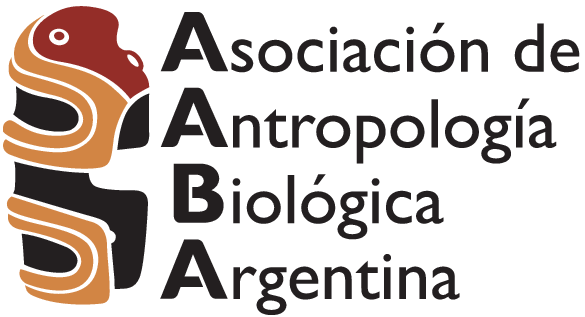Uso de un enfoque de morfometría geométrica basado en semi-hitos de superficie para la estimación del dimorfismo sexual en huesos craneales
DOI:
https://doi.org/10.24215/18536387e068Palabras clave:
dimorfismo sexual, rasgos craneales, morfometría geométrica, semihitos de superficie 3DResumen
Tradicionalmente, la estimación del sexo en cráneos humanos se ha llevado a cabo aplicando enfoques no métricos y de distancias entre hitos. Dicha estimación ha mejorado sustancialmente con la introducción del registro morfométrico geométrico basado en semi-hitos, lo que representa una herramienta útil para capturar la compleja morfología de las superficies 3D, particularmente la del cráneo humano. Considerando estos avances, el objetivo principal de este estudio es mostrar la utilidad de estas técnicas para evaluar mediante un enfoque cuantitativo con contrastación de hipótesis la expresión fenotípica diferencial del dimorfismo sexual en los rasgos craneales humanos, utilizando el hueso frontal, la apófisis mastoides del hueso temporal y el hueso cigomático como referentes. Según nuestros principales resultados: i) la exactitud y precisión de la estimación del sexo es mayor cuando se incluyen los componentes de la forma en los análisis que cuando no se hace; ii) la clasificación numérica resulta con mayores aciertos en los hombres que en las mujeres, tanto para los componentes de forma como de tamaño del dimorfismo sexual; y iii) uno o dos rasgos combinados arrojan mejores resultados en la clasificación numérica del sexo que los tres rasgos tomados en conjunto. La introducción en el presente estudio de un enfoque basado en semi-hitos de superficie para evaluar cuantitativamente el dimorfismo sexual en el cráneo humano corrobora la importancia de la información aportada por la superficie del hueso frontal, la apófisis mastoides y el hueso cigomático, lo cual mejora considerablemente, de este modo, la estimación del dimorfismo sexual. Nuestros resultados sugieren que los componentes de forma y tamaño deberían considerarse como factores relevantes para realizar una estimación del sexo en cráneos humanos de carácter diferencial y ponderada por el tipo de hueso.
Descargas
Métricas
Citas
Adams, D. C. y Otárola-Castillo, E. (2013). Geomorph: An r package for the collection and analysis of geometric morphometric shape data. Methods in Ecology and Evolution, 4(4), 393-399. https://doi.org/10.1111/2041-210X.12035
Adams, D., Rohlf, F. y Slice, D. (2004). Geometric morphometrics: Ten years of progress following the ‘revolution.’ Italian Journal of Zoology, 71(1), 5-16. https://doi.org/10.1080/11250000409356545
Bardua, C., Felice, R. N., Watanabe, A., Fabre, A. C. y Goswami, A. (2019). A Practical Guide to Sliding and Surface Semilandmarks in Morphometric Analyses. Integrative Organismal Biology, 1(1). https://doi.org/10.1093/iob/obz016
Barreaux, N., Espinoza M.C., Flores, S., Galimany, J., González, R., Jara, K., Krapivka, S., Morales, H. y Quiñones, E. (2015). Puesta en valor de la colección osteológica subactual de Santiago (Sesión de Congreso) V Congreso Chileno de Conservación y Restauración. DIBAM-AGCR (pp. 183-189). https://www.cncr.gob.cl/noticias/v-congreso-chileno-de-conservacion-yrestauracion
Baylac, M. y Frieß, M. (2006). Fourier descriptors, Procrustes superimposition, and data dimensionality: an example of cranial shape analysis in modern human populations. En D.E. Slice (Ed.), Modern Morphometrics in Physical Anthropology (pp. 145-165). https://doi.org/10.1007/0-387-27614-9_6
Bigoni, L., Velemínská, J. y Brůžek, J. (2010). Three-dimensional geometric morphometric analysis of cranio-facial sexual dimorphism in a Central European sample of known sex. HOMO- Journal of Comparative Human Biology, 61(1), 16-32. https://doi.org/10.1016/j.jchb.2009.09.004
Bookstein, F. L. (1991). Morphometric tools for landmark data: geometry and biology. Cambridge University Press.
Boyer, D., Lipman, Y., St Clair, E., Puente, J., Patel, B., Funkhouser, T., Jernvall, J. y Daubechies, I. (2011). Algorithms to automatically quantify the geometric similarity of anatomical surfaces. Proceedings of the National Academy of Sciences of the United States of America, 108(45), 18221-18226. https://doi.org/10.1073/pnas.1112822108
Boyer, D., Puente, J., Gladman, J., Glynn, C., Mukherjee, S., Yapuncich, G. y Daubechies, I. (2015). A new fully automated approach for aligning and comparing shapes. Anatomical Record (Hoboken, N.J.: 2007), 298(1), 249-276. https://doi.org/10.1002/ar.23084
Carlson, K. J., Grine, F. E. y Pearson, O. M. (2007). Robusticity and sexual dimorphism in the postcranium of modern hunter-gatherers from Australia. American Journal of Physical Anthropology, 134(1), 9-23. https://doi.org/10.1002/ajpa.20617
Chovalopoulou, M. E., Valakos, E. D. y Manolis, S. K. (2016). Sex determination by three-dimensional geometric morphometrics of the vault and midsagittal curve of the neurocranium in a modern Greek population sample. HOMO-Journal of Comparative Human Biology, 67(3), 173-187. https://doi.org/10.1016/j.jchb.2015.09.007
Del Bove, A., Profico, A., Riga, A., Bucchi, A. y Lorenzo, C. (2020). A geometric morphometric approach to the study of sexual dimorphism in the modern human frontal bone. American Journal of Physical Anthropology, 173(4), 643-654. https://doi.org/10.1002/ajpa.24154
Díaz-Jarufe, P. (2010). Valor predictivo de los rasgos anatómicos del cráneo utilizados en la estimación visual del sexo en población chilena: un análisis de morfometría geométrica. (Tesis de Licenciatura, Universidad de Chile, Santiago de Chile). https://repositorio.uchile.cl/handle/2250/106304
DiGangi, E. A. y Moore, M. K. (Eds.) (2013). Research Methods in Human Skeletal Biology. Elsevier Academic Press. https://doi.org/10.1016/B978-0-12-385189-5.00001-7
Faul, F., Erdfelder, E., Lang, A.-G. y Buchner, A. (2007). G*Power 3: A flexible statistical power analysis program for the social, behavioral, and biomedical sciences. Behavior Research Methods, 39, 175- 191. https://doi.org/10.3758/BF03193146
Franklin, D., Freedman, L., Milne, N. y Oxnard, C. E. (2006). A geometric morphometric study of sexual dimorphism in the crania of indigenous southern Africans. South African Journal of Science, 102(5), 229-238. https://journals.co.za/doi/pdf/10.10520/EJC96545
Garvin, H. M. (2012). Adult Sex Determination: Methods and Application. A Companion to Forensic Anthropology, 239-247. https://doi.org/10.1002/9781118255377.ch12
Garvin, H. M. y Ruff, C. B. (2012). Sexual dimorphism in skeletal browridge and chin morphologies determined using a new quantitative method. American Journal of Physical Anthropology, 147(4), 661-670. https://doi.org/10.1002/ajpa.22036
Gonzalez, P., Bernal, V. y Perez, S. (2011). Analysis of sexual dimorphism of craniofacial traits using geometric morphometric techniques. International Journal of Osteoarchaeology, 21(1), 82-91. https://doi.org/10.1002/oa.1109
Gonzalez, P. N., Perez, S. I. y Bernal, V. (2010). Ontogeny of robusticity of craniofacial traits in modern humans: a study of South American populations. American Journal of Physical Anthropology, 142(3), 367-379. https://doi.org/10.1002/ajpa.21231
Green, H. y Curnoe, D. (2009). Sexual dimorphism in Southeast Asian crania: A geometric morphometric approach. HOMO-Journal of Comparative Human Biology, 60(6), 517-534. https://doi.org/10.1016/j.jchb.2009.09.001
Gunz, P. y Mitteroecker, P. (2013). Semilandmarks: a method for quantifying curves and surfaces. Hystrix, the Italian Journal of Mammalogy, 24(1), 103-109. https://doi.org/10.4404/hystrix-24.1-6292
Gunz, P., Mitteroecker, P. y Bookstein, F. L. (2005). Semilandmarks in Three Dimensions. Modern Morphometrics in Physical Anthropology, 73-98. https://doi.org/10.1007/0-387-27614-9_3
Hammer, Ø., Harper, D. A. T. y Ryan, P. D. (2001). PAST: Paleontological statistics software package for education and data analysis. Palaeontologia Electronica, 4(1), 9.
Jung, H. y Woo, E. J. (2016). Evaluation of Mastoid Process as Sex Indicator in Modern White Americans using Geometric Morphometrics. Journal of Forensic Sciences, 61(4), 1029-1033. https://doi.org/10.1111/1556-4029.13079
Kimmerle, E. H., Ross, A. y Slice, D. (2008). Sexual dimorphism in America: Geometric morphometric analysis of the craniofacial region. Journal of Forensic Sciences, 53(1), 54-57. https://doi.org/10.1111/j.1556-4029.2007.00627.x
Lewis, C. J. y Garvin, H. M. (2016). Reliability of the Walker Cranial Nonmetric Method and Implications for Sex Estimation. Journal of Forensic Sciences, 61(3), 743-751. https://doi.org/10.1111/1556-4029.13013
Martin R, S. K. (1957). Lehrbuch der Anthropologie in systematischer Darstellung. Fischer.
Meza-Escobar, O., Galimany, J., González-Oyarce, R. y Höpfl, N. B. (2023). The Colección Osteológica Subactual de Santiago: Origin and Current State of a Documented Skeletal Collection from Chile, Latin America. Forensic Sciences, 3(1), 80-93. https://doi.org/10.3390/forensicsci3010008
Perlaza, N. A. (2014). Sex determination from the frontal bone: A geometric morphometric study. Journal of Forensic Sciences, 59(5), 1330-1332. https://doi.org/10.1111/1556-4029.12467
Petaros, A., Garvin, H. M., Sholts, S. B., Schlager, S. y Wärmländer, S. K. T. S. (2017). Sexual dimorphism and regional variation in human frontal bone inclination measured via digital 3D models. Legal Medicine, 29, 53-61. https://doi.org/10.1016/j.legalmed.2017.10.001
Pomidor, B., Makedonska, J. y Slice, D. (2016). A Landmark-Free Method for Three-Dimensional Shape Analysis. PLOS ONE, 11(3), e0150368. https://doi.org/10.1371/journal.pone.0150368
Pretorius, E., Steyn, M. y Scholtz, Y. (2006). Investigation into the usability of geometric morphometric analysis in assessment of sexual dimorphism. American Journal of Physical Anthropology, 129(1), 64-70. https://doi.org/10.1002/ajpa.20251
Püschel, T. (2013). Biomechanical modelling of Human Femora: a comparison between Agriculturalist and Hunter-Gatherers using FEA, GMM and Beam Theory. (Tesis de Maestría, University of York, York). https://www.thomaspuschel.com/publication/msc/
R Core Team. (2008). R: a language and environment for statistical computing. R Foundation for Statistical Computing.
Rodríguez, F. (2017). Dimorfismo Sexual del Diente Canino en Población Santiaguina Actual aplicando Morfometría Geométrica. Tesis para optar al título de Antropólogo. (Tesis de Licenciatura, Universidad de Chile, Santiago de Chile). https://repositorio.uchile.cl/handle/2250/152568
Rohlf, J. y Marcus, L. (1993). A revolution morphometrics. Trends in Ecology and Evolution 8(4), 129-132. https://doi.org/10.1016/0169-5347(93)90024-J
Rosas, A. y Bastir, M. (2002). Thin-plate spline analysis of allometry and sexual dimorphism in the human craniofacial complex. American Journal of Physical Anthropology, 117(3), 236-245. https://doi.org/10.1002/ajpa.10023
Schlager, S. (2017). Morpho and Rvcg – Shape Analysis in R: R-Packages for Geometric Morphometrics, Shape Analysis and Surface Manipulations. Statistical Shape and Deformation Analysis: Methods, Implementation and Applications, 217-256. https://doi.org/10.1016/B978-0-12-810493-4.00011-0
Schlager, S., Jefferis, G. y Ian, D. (2018). Package “Morpho” Type Package Title Calculations and Visualisations Related to Geometric Morphometrics. R package Version 2.11. https://cran.rproject.org/web/packages/Morpho/index.html
Schlager, S. y Rüdell, A. (2017). Sexual Dimorphism and Population Affinity in the Human Zygomatic Structure—Comparing Surface to Outline Data. Anatomical Record, 300(1), 226-237. https://doi.org/10.1002/ar.23450
Shearer, B. M., Sholts, S. B., Garvin, H. M. y Wärmländer, S. K. T. S. (2012). Sexual dimorphism in human browridge volume measured from 3D models of dry crania: A new digital morphometrics approach. Forensic Science International, 222(1-3), 400.e1-400.e5. https://doi.org/10.1016/j.forsciint.2012.06.013
Slice, D. (2007). Geometric Morphometrics. Annual Review of Anthropology, 36, 261-281. https://doi.org/10.1146/ANNUREV.ANTHRO.34.081804.120613
Stratovan Corporation. (2018). Stratovan Checkpoint (Version 2018.08.07). (Software). Sacramento, CA: Stratovan Corporation Incorporated.
Suazo Galdames, I. C., Zavando Matamala, D. A. y Smith, R. L. (2008). Sex Determination Using Mastoid Process Measurements in Brazilian Skulls. International Journal of Morphology, 26(4), 941-944. http://dx.doi.org/10.4067/S0717-95022008000400025
Ubelaker, D. y Buikstra J. (1994). Standards for data collection from human skeletal remains. Arkansas Archaeological Survey, 44-206.
Valenzuela, C. Y. y Harb, Z. (1977). Socioeconomic assortative mating in Santiago, Chile: a demonstration using stochastic matrices of mother-child relationships applied to ABO blood groups. Social Biology, 24(3), 225-233. https://doi.org/10.1080/19485565.1977.9988285
Walker, P. L. (2008). Sexing skulls using discriminant function analysis of visually assessed traits. American Journal of Physical Anthropology, 136(1), 39-50. https://doi.org/10.1002/ajpa.20776
Walrath, D. E., Turner, P. y Bruzek, J. (2004). Reliability Test of the Visual Assessment of Cranial Traits for Sex Determination. American Journal of Physical Anthropology, 125, 132-137. https://doi.org/10.1002/ajpa.10373
Watanabe, A. (2018). How many landmarks are enough to characterize shape and size variation? PLOS ONE, 13(6), e0198341. https://doi.org/10.1371/journal.pone.0198341
Weber, G. W. (2015). Virtual Anthropology. American Journal of Physical Anthropology, 156(S59), 22-42. https://doi.org/10.1002/ajpa.22658
Williams, B. A. y Rogers, T. L. (2006). Evaluating the Accuracy and Precision of Cranial Morphological Traits for Sex Determination. Journal of Forensic Sciences, 51(4), 729-735. https://doi.org/10.1111/j.1556-4029.2006.00177.x
Zelditch, M., Swiderski, D. y Sheets, H. (2012). Geometric Morphometrics for Biologists: A Primer. (2a ed.). Elsevier Academic Press.
Descargas
Archivos adicionales
Publicado
Cómo citar
Número
Sección
Licencia
Derechos de autor 2023 Germán Manríquez, Bastián Escobar-RamírezLa RAAB es una revista de acceso abierto tipo diamante. No se aplican cargos para la lectura, el envío de los trabajos ni tampoco para su procesamiento. Asímismo, los autores mantienen el copyright sobre sus trabajos así como también los derechos de publicación sin restricciones.


































